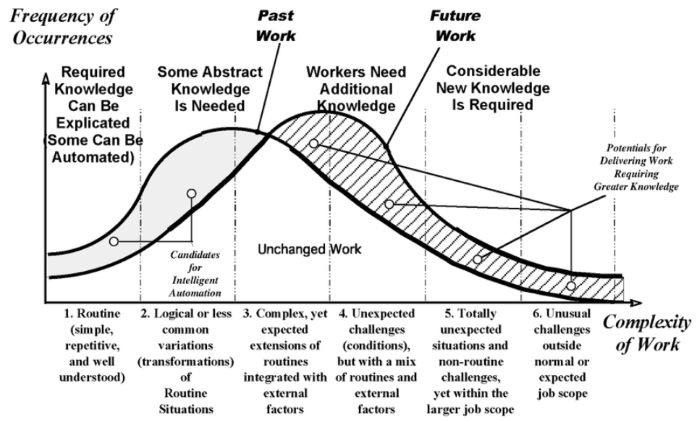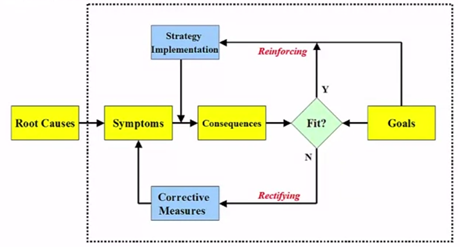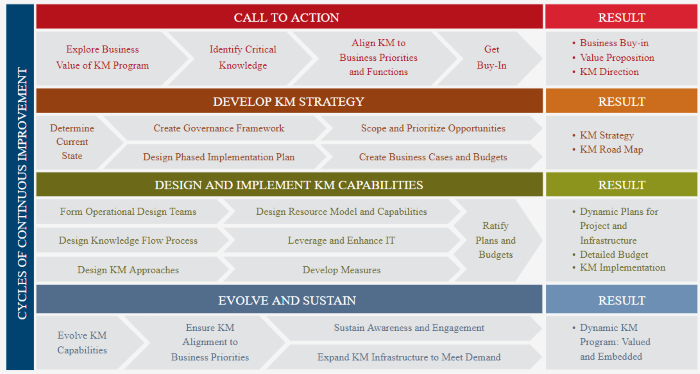Good to Know your Information
14th of March 2018Having previously mentioned Knowledge Management (KM) as a sub-discipline of Enterprise Information Mangement (EIM), and pointed out that KM should be an ongoing process in the organization, as defined by the KM cycle of Kimiz Dalkir, this article dives deeper into the nature of KM: why there is a need for it, and how to go about it.
The need for Knowledge Management can be summarized in the graph that was published by the Knowledge Research Institute Inc (KRII) in 2004, showing that the nature of future work will shift increasingly to more knowledge work, and that simple, repetitive tasks will be a prime candidate for intelligent automation. This view has already come to fruition in current days, and the graph will shift more and more to a lopsided curve to the right of the graph, increasing the tasks that will be automated as well as those tasks requiring additional knowledge.

Knowledge Research Institute Inc (2004)
The goal is to integrate a Knowledge Management process into the company culture so that a Learning Organization is created. Learning is at the centre of an organisation’s efforts to increase their capabilities in order to further their strategic goals. We define a learning organisation as one that is skilled at creating, acquiring and transferring knowledge, and one who is capable of modifying their way of working to match this knowledge and the insights that are extracted from this knowledge. Evidently, this learning must be continuous and dynamic for it to serve as a basis for an evolution in the knowledge base of the organisation. And for it to permeate the organisation, this learning must be structurally integrated in the workings of the organisation. It must become a part of the overall business processes governing said organisation.
This is elaborated in Peter Senge’s 1993 book “The Fifth Discipline – The Art & Practice of The Learning Organization”. He advocates a Shared Vision, co-created and shared by all employees of the organization instead of a top-down vision statement by upper management. My personal view is that this might be too much to expect from your employees, especially when companies have more employees than a typical small business. Top-down vision statements are valid when enough employee buy-in can be assured. The Shared Vision works hand in hand with the organizational Mental Model, which is the aggregation of all presumptions and generalizations that influence employee behaviour. A typical example of this is the official company hierarchy.
On the other hand, the other three principles Peter Senge described are valid across all organization types: Personal Mastery, Team Learning, and System Thinking. These concepts are straightforward enough. Personal Master focuses on the individual employee and how his tailored learning path and proactive learning efforts assist him to continuously achieve results that are beneficial to the organization and that he can take professional pride in. The two factors deciding what to learn are what is important to the employee and the reality of the business in which his organization is situated. Team Learning focuses on learning how to coordinate efforts of groups of employees to achieve results not achievable by a single employee. Forging the combination of these two forms of learning into managed processes is called by Senge as System Thinking.
There exist several techniques for this type of organizational learning, one of which was postulated by Professor Chris Argyris of Harvard Business School. He identifies three possible levels of learning techniques in an organisation, which he coined single-loop, double-loop and deutero learning. The idea is that with Single-loop learning we adjust the capability so that variances in results are addressed. We can look at this as attacking the symptoms of a supply chain problem. With double-loop learning we search for the underlying reason for the symptoms of a problem and try to remedy this reason in order to make sure the symptoms no longer occur. One might conclude that double-loop learning is a sounder strategy for attacking problems, but this is incorrect. Both are needed for a balanced resolution of the issues with a supply chain. Take for instance the occurrence of a fire. One needs to address putting out the flames (symptom) before being able to tackle the underlying reason. The balanced application of both of these levels is called deutero learning, which is the preferred manner of proceeding. Deutero learning focuses on improving the methods used for single- and double-loop learning, primarily by introspection on how learning itself is happening in the organization. This is also a topic that comes up in Robert Kaplan’s book on the Balanced Score Card.

Single-Loop (Reinforcing) and Double-Loop (Rectifying) Learning
Not all knowledge might be easily diffusible across the organization, or be easily accessed. We make the distinction between explicit knowledge and tacit knowledge. Tacit knowledge is present in the heads of those in the know, and can therefore still act favorably towards a strategic goal. Typically, tacit knowledge is formed by either socialization or internalization. Socialization is the phenomenon where employees share information with one another on an individual basis, or when information or skills are picked up by an employee through the observation of other employees. Internalization is the process where an employee acquires explicit knowledge and then expands on it in his own frame of mind without rendering these insights explicit. The table below gives a quick comparison between these two types of knowledge.
| Properties of tacit knowledge | Properties of explicit knowledge |
|---|---|
| Ability to adapt, to deal with new and exceptional situations | Ability to disseminate, to reproduce, to access and re-apply throughout the organization |
| Expertise, know-how, know-why, and care-why | Ability to teach, to train |
| Ability to collaborate, to share a vision, to transmit a culture | Ability to organize, to systematize, to translate a vision into a mission statement, into operational guidelines |
| Coaching and mentoring to transfer experiential knowledge on a one-to-one, face-to-face basis | Transfer knowledge via products, services, and documented processes |
Take heed that there exists a popular misconception that all tacit knowledge should be converted to explicit knowledge. Even tacit knowledge can be managed, and therefore the cost of transcribing tacit knowledge into a standardized, formalized structure should be assessed against the benefits. It is important to align efforts for formalizing knowledge with the particularities of corporate culture and human nature. There are always reasons to be found why people are willing to share information (for example to take pride in their expertise or because of time pressure to deliver), and why people are not willing to share (for example taking pride into not having to seek advice or help from others or because of a bonus system on performance). A possible technique for mapping the knowledge relationships and flows between people is for example Social Network Analysis.
Another way of creating explicit knowledge is to form communities around specific topics. I have seen my share of initiatives trying to launch such a concept in organizations, with names ranging from squad to competence center, but a common pitfall looms around the corner. Typically, these initiatives are constructed outside of working hours, with no real deliverables or expectations given to them. If this practice is not organized in a structure manner, meaning using corporate resources (work time, incentives…) and no clear objective is set, they tend to die a slow death as more and more participants put preference in other pursuits (either career or personal), or just lose interest or belief in what such communities can achieve.
One way to tackle an overall approach to Knowledge Management is the KM framework provided by APQC. This is an implementation of the KM cycle of Kimiz Dalkir mentioned in the beginning of this article. An interactive version of this model is provided on the APQC website, as well as numerous articles on this topic. Other methodologies (for example the PWC KM Project Methodology) have a similar approach.

APQC Knowledge Management Program Framework
| Thought | EIM |